Dr. Zoe A. Grosser, PerkinElmer Life and Analytical Sciences
Identifying and quantifying the presence of metals is an important factor in determining environmental, public health and product quality. Metals can be either harmful or beneficial, and the amount of the metal present in a given substance often is the sole determinant of which effect is observed. Since the advent nearly 40 years ago of commercial instruments that can sensitively measure metal concentration levels, the scope of elements detected and the limits of detection have steadily improved.
Metals are commonly measured using one of three technologies: atomic absorption (AA), inductively coupled plasma optical emission (ICP-OES) or inductively coupled plasma mass spectrometry (ICP-MS) (Figure 1). X-ray fluorescence also is widely used, but has a more limited scope and will not be included in this discussion.
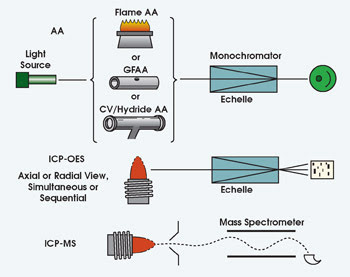
Figure 1. This diagram illustrates the operation of three common techniques for measuring metals.
Why do analysts care about lower detection limits? In many cases, the demand for more information is driven by government regulations. Consider the field of environmental analysis. Some metals are known to be toxic, or to have endocrine-disrupting capabilities, at low concentrations. If a government regulation to limit exposure from drinking water is put into place, compliance would be difficult without reliable measurements of the element at the regulatory level; in fact, as a rule of thumb, a detection limit approximately 10 times below the regulatory limit is generally considered prudent (Table 1). This is especially true when enforcement involves significant fines or a lawsuit as a result.
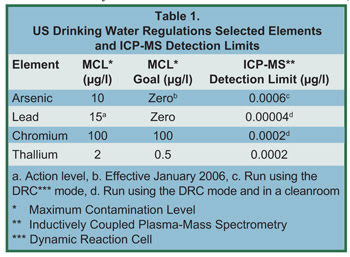 Measuring Contaminants
Measuring Contaminants
Economic forces also can drive metal-detection limits. For example, semiconductor companies can increase chip yield if the materials that go into making them are extremely clean. But metal contaminants are especially troublesome because they change the electric properties of the material and contribute to defects.
Therefore, a critical part of the semiconductor manufacturing process is the measurement of potential contaminants in all incoming raw materials, such as water, acids and silicon. And as the drive to decrease the feature size is coupled with larger wafers to produce larger batches of chips, information on contamination at the parts-per-trillion level is necessary. Lower detection limits also can provide information on each component material so that the overall metal content can be strictly controlled.
Detection limits also can be driven by new information that can be obtained. Speciation analysis can yield more information about the toxicity, bioavailability and mobility of a sample than a measurement of the total metal content. The Centers for Disease Control and Prevention is developing speciation methods as part of its biomonitoring studies. Recent work demonstrated the separation and detection of various forms of arsenic that may be present in urine.
Because different molecular forms of arsenic, such as monomethyl arsenic and arsenobetaine, have dramatically different human toxicities, researchers must understand how the arsenic is bound in a given product or sample. The detection limit is important because the total arsenic content is separated into species, with individual components measured at much lower levels than the total concentration.
How have commercially available instruments responded to the challenge of lower detection limits? When atomic absorption was introduced in the early 1960s, flame was the only means of generating the atomic vapor subject to light absorption. In 1969, furnace atomic absorption was introduced, allowing researchers to test smaller samples and contain the vapor in a small volume. Those improvements yielded detection limit improvements of 10 times or more.
Later, the development of ICP-OES provided detection-limit improvements for elements that were difficult to atomize. And ICP-MS, introduced in the 1980s, provided a nonoptical, highly sensitive means of detecting ions by their mass/charge ratio. By way of comparison, those earliest atomic absorption instruments were capable of measuring lead with a detection limit of approximately 300 mg/l; today, thanks to modern ICP-MS technology, lead can be measured at a concentration of 0.00004 mg/l. Further, ICP-OES and ICP-MS are multielement techniques, so they can measure many elements at the same time, thereby increasing laboratory productivity (Table 2).
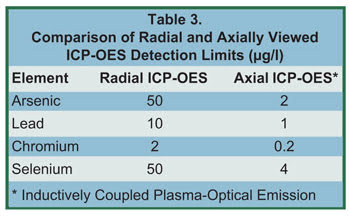 Improvements continue
Improvements continue
Recent developments in ICP-OES and ICP-MS have further improved detection limits. In the early 1990s, the ability to collect light from an ICP along the length of the plasma (axial), rather than from a small section of the side (radial), improved detection limits by approximately 10 times. This development gave analysts the flexibility to use radial viewing for elements such as sodium, which has a strong emission signal, and axial viewing for arsenic, which is less sensitively detected.
In combination with a solid-state detector designed for ICP-OES to reduce source flicker noise, photon shot noise, detector dark current noise and electronic readout noise, detection limits in both modes have improved (Table 3).1
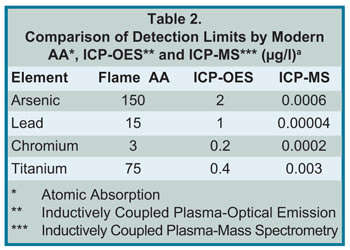 Detection limits also have improved in ICP-MS with the implementation of a dynamic reaction cell to selectively control chemical reactions (Table 4). Isobaric interferences are a major cause of detection-limit deterioration, especially when the overlap is the most abundant mass for an element. By filling the cell with a selected reaction gas, either the analyte of interest can be reacted to move the detection mass away from interference, or the reaction gas can be used to move the interference away from the analyte mass.
Detection limits also have improved in ICP-MS with the implementation of a dynamic reaction cell to selectively control chemical reactions (Table 4). Isobaric interferences are a major cause of detection-limit deterioration, especially when the overlap is the most abundant mass for an element. By filling the cell with a selected reaction gas, either the analyte of interest can be reacted to move the detection mass away from interference, or the reaction gas can be used to move the interference away from the analyte mass.
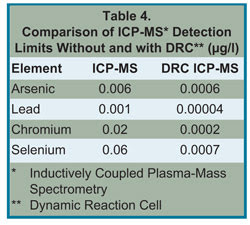 The moral of the story? The more you improve detection limits, the more users will find ways to improve public health and product quality, and to advance research. Then, instrument developers will respond by lowering detection limits still further, and the cycle will repeat itself. Zero may never be an achievable goal, but it won’t be for a lack of effort.
The moral of the story? The more you improve detection limits, the more users will find ways to improve public health and product quality, and to advance research. Then, instrument developers will respond by lowering detection limits still further, and the cycle will repeat itself. Zero may never be an achievable goal, but it won’t be for a lack of effort.
References
1. T.W. Barnard et al (1993). ANALYTICAL CHEMISTRY, Vol. 65, p. 1231.
Contact: Zoe Grosser, strategic marketing manager of environmental and chemical analysis, PerkinElmer Life and Analytical Sciences, Shelton, Conn.; e-mail [email protected].